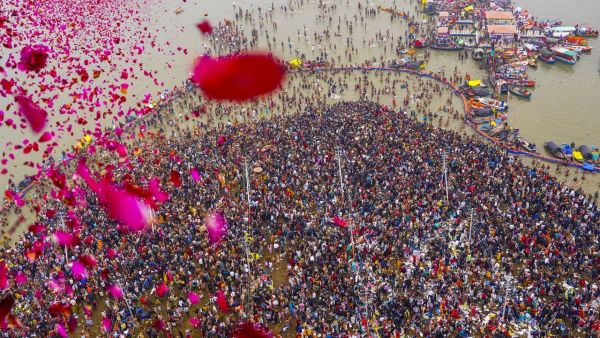
Mumbai: The divine and grand event of Kumbh Mela is currently taking place in Prayagraj, Uttar Pradesh. Despite the biting cold, a sea of devotees has gathered at the Sangam (the confluence of rivers) to showcase their unwavering faith. The atmosphere resonates with the chants of Sanatan Dharma, and the presence of international devotees further adds to the global appeal of the event. The entire area radiates spirituality, drawing people from all walks of life to witness this extraordinary gathering.
Amidst this fervour, questions and myths surrounding Kumbh Mela often emerge. How did it originate? Why is it celebrated every 12 years? And how are the locations determined? This article unravels the mystique behind this ancient festival, shedding light on its origins, significance, and organisation.
The word “Kumbh” is derived from Sanskrit, meaning a pitcher. According to mythology, during the churning of the ocean (Samudra Manthan) by the gods (Devas) and demons (Asuras), Dhanvantari emerged carrying a pot of nectar (Amrit). To prevent the demons from seizing it, Indra’s son, Jayant, fled with the pot. He was accompanied and protected by Surya (Sun), Shani (Saturn), Brihaspati (Jupiter), and Chandra (Moon). During this chase, drops of nectar fell at four locations: Haridwar, Prayagraj, Ujjain, and Nashik-Trimbakeshwar. Thus, these places became significant for the celebration of Kumbh Mela.
The chase for the nectar pot lasted 12 divine days, equivalent to 12 human years. Therefore, the Kumbh Mela is organised every 12 years. The event’s timing is determined by the relative positions of the Sun, Moon, and Jupiter. These alignments, known as astrological calculations, decide the dates and locations for the Mela.
Each of the four Kumbh Mela sites holds unique spiritual importance due to their association with rivers:
| Location | River(s) | Significance |
| Haridwar | Ganga |
Ganga is considered the holiest river in Hinduism.
|
| Prayagraj | Ganga, Yamuna, and Saraswati (Triveni Sangam) |
The confluence of three sacred rivers.
|
| On your fingers | Kshipra |
Believed to flow from the heart of Lord Vishnu in his Varaha avatar.
|
| Nashik-Trimbakeshwar | Godavari |
Referred to as the “Ganga of the South.”
|
It is believed that taking a dip in these rivers during Kumbh Mela washes away sins and grants spiritual merit.
The choice of location for Kumbh Mela is based on precise astrological calculations. Here are the combinations for each site:
| Location |
Astrological Alignment
|
| Haridwar |
Jupiter in Aquarius (Kumbh), Sun in Aries, Moon in Sagittarius
|
| Prayagraj |
Jupiter in Taurus, Sun and Moon in Capricorn
|
| On your fingers |
Jupiter in Leo, Sun and Moon in Cancer
|
| Nashik-Trimbakeshwar |
Jupiter in Leo, Sun and Moon in Cancer (also called Singhasta Kumbh)
|
In addition to the 12-year cycle, Prayagraj and Haridwar also host the Ardh Kumbh (half Kumbh) every six years. The grander celebration, known as the Maha Kumbh, takes place every 12 years.
Kumbh Mela is not merely a festival; it is a spiritual congregation that attracts millions of people seeking salvation. The event embodies the essence of Sanatan Dharma and serves as a platform for devotees to connect with their roots. The Mela’s timeless appeal lies in its deep-rooted spiritual significance, which transcends generations and geographies.
Whether it is the icy waters of the Ganga in Haridwar or the confluence at Prayagraj, the Kumbh Mela continues to inspire awe and devotion, making it one of the world’s largest and most celebrated festivals.